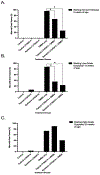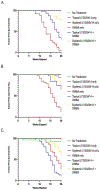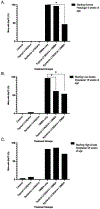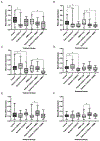Systemic Delivery of a Dual PI3K/mTOR Inhibitor More Effective than Topical Delivery in Preventing Anal Carcinogenesis in an HPV Transgenic Mouse Model
- PMID: 36683775
- PMCID: PMC9851170
- DOI: 10.26502/jcsct.5079153
Systemic Delivery of a Dual PI3K/mTOR Inhibitor More Effective than Topical Delivery in Preventing Anal Carcinogenesis in an HPV Transgenic Mouse Model
Abstract
Introduction: Anal dysplasia is a growing health concern that over time can result in squamous cell carcinoma (SqCC) of the anus. In this study, we compare a topical versus systemic (oral) administration of LY3023414, a dual PI3K/mTOR inhibitor, to prevent anal carcinogenesis in a Human Papillomavirus (HPV) mouse model of anal cancer.
Materials and methods: K14E6/E7 transgenic mice were used to model HPV-induced anal carcinogenesis. Mice with varying starting anal histologies (normal histology, low-grade, and high-grade anal dysplasia) were treated topically at the anus or systemically via oral gavage with LY3023414 with or without topical carcinogen for 20 weeks. Mice were monitored for overt anal tumor development and anal tissue was assessed for histology and markers of PI3K and mTOR activity (pAKT and pS6, respectively).
Results: LY3023414 treatment, regardless of the mode of delivery, significantly decreased overt tumor development in mice starting with normal histology and low-grade anal dysplasia. Systemic LY3023414 treatment was more effective in delaying tumor onset than topical treatment. Mice treated with systemic LY3023414 had significantly reduced rates of anal SqCC when starting with normal and low-grade anal dysplasia compared to topical treatment. Topical treatment was only effective in reducing SqCC in the setting of low-grade dysplasia. LY3023414 inhibition of pAKT and pS6 expression varied with starting histology. Neither treatment mode was effective in the setting of high-grade anal dysplasia.
Conclusion: Systemic LY3023414 treatment was more effective than topical application in delaying the progression of normal anal histology and low-grade dysplasia to anal cancer in HPV-associated mice.
Keywords: Anal cancer; Anal dysplasia; Dual PI3K/mTOR inhibitor; LY3023414; Squamous cell carcinoma of the anus.
Conflict of interest statement
Conflicts of Interest The authors declare that they have no conflicts of interest/competing interests.
Figures




Similar articles
-
PI3K/mTOR inhibition prevents anal cancer in mice with established low-grade anal dysplasia.Exp Mol Pathol. 2022 Apr;125:104752. doi: 10.1016/j.yexmp.2022.104752. Epub 2022 Feb 18. Exp Mol Pathol. 2022. PMID: 35183509 Free PMC article.
-
Topical application of a dual PI3K/mTOR inhibitor prevents anal carcinogenesis in a human papillomavirus mouse model of anal cancer.Eur J Cancer Prev. 2019 Nov;28(6):483-491. doi: 10.1097/CEJ.0000000000000505. Eur J Cancer Prev. 2019. PMID: 30888976 Free PMC article.
-
Anal Cancer Prevention Through the Topical Use of Single or Dual PI3K/mTOR Inhibitors.J Surg Res. 2023 Feb;282:137-146. doi: 10.1016/j.jss.2022.09.025. Epub 2022 Oct 20. J Surg Res. 2023. PMID: 36274448
-
[Preneoplastic anal lesions and anal canal carcinoma].Bull Cancer. 2003 May;90(5):405-11. Bull Cancer. 2003. PMID: 12850763 Review. French.
-
Clinical results of infrared coagulation as a treatment of high-grade anal dysplasia: a systematic review.Tech Coloproctol. 2019 Aug;23(8):707-712. doi: 10.1007/s10151-019-02041-7. Epub 2019 Jul 23. Tech Coloproctol. 2019. PMID: 31338711
Cited by
-
Topical Protease Inhibitor Decreases Anal Carcinogenesis in a Transgenic Mouse Model of HPV Anal Disease.Viruses. 2023 Apr 20;15(4):1013. doi: 10.3390/v15041013. Viruses. 2023. PMID: 37112993 Free PMC article.
References
-
- SEER Cancer Stat Facts: Anal Cancer. National Cancer Institute; (2021).
-
- Wieland U, Kreuter A. The importance of HPV16 in anal cancer prevention. The Lancet Infectious Diseases 18 (2017): 131–132. - PubMed
-
- Blazy A, Hennequin C, Gornet JM, et al. Anal carcinomas in HIV-positive patients: high-dose chemo radiotherapy is feasible in the era of highly active antiretroviral therapy. Dis Colon Rectum 48 (2005): 1176–1181. - PubMed
Grants and funding
LinkOut - more resources
Full Text Sources
Miscellaneous
